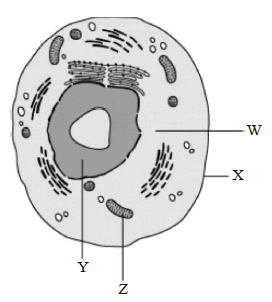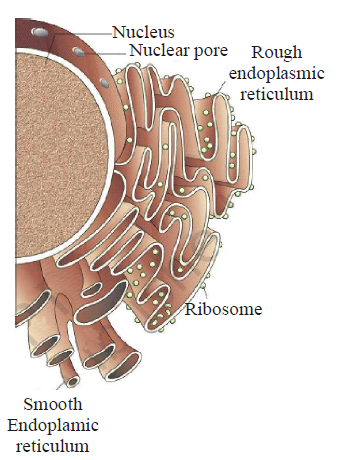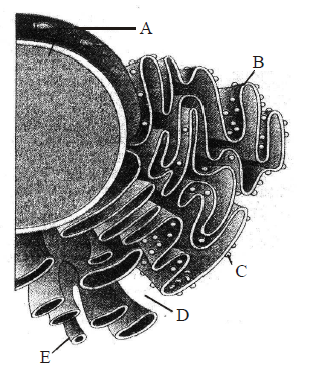In prokaryotes, chromatophores are
specialized granules responsible for colouration of cells
structures responsible for organizing the shape of the organism.
inclusion bodies lying free inside the cells for carrying out various metabolic activities.
internal membrane system which becomes extensive and complex in photosynthetic bacteria.
Correct Answer :
D. internal membrane system which becomes extensive and complex in photosynthetic bacteria.
In some prokaryotes like cyanobacteria, there are membranous extensions into the cytoplasm called chromatophores which contain pigments.
Related Questions

Which function is carried out by the cell organelle 'X'?
helps control the movement of substance in and out of the cell
passes information from the parent cell to newly formed cell
maintains the proper shape of the cell and serves as a protective barrier
helps the cell to make food with the help of chlorophyll and sunlight
Statement 1: Centrosomes and centrioles are related to each other.
Statement 2: Centrosome usually contains two cylindrical structures called centrioles.
Both statements -1 and statement - 2 are true and statement - 2 is the correct explanation of statement - 1.
Both statements -1 and statement - 2 are true but statement - 2 is not the correct explanation of statement - 1.
Statement -1 is true and statement - 2 is false.
Statement -1 is false and statement - 2 is true.
The given diagram shows the types of chromosomes (labelled as A, B, C & D) based on the position of centromere.
Which one is the correct option for the labelled chromosomes. A, B, C and D ?

A Telocentric chromosome, B Acrocentric chromosome, C Submetacentric chromosome, D Metacentric chromosome
A Acrocentric chromosome, B Telocentric chromosome, C Metacentric chromosome, D Submetacentric chromosome
A Submetacentric chromosome, B Metacentric chromosome, C Telocentric chromosome, D Acrocentric chromosome
A Metacentric chromosome, B Submetacentric chromosome, C Acrocentric chromosome, D Telocentric chromosome.
_______________ is the important site of formation of glycoproteins and golycolipids.
SER
Lysosome
Golgi apparatus
Mitochondria
Study the following statements on cilium or flagellum and answer the question.
- Cilium / Flagellum contains an outer ring of nine doublet microtubules surrounding two singlet microtubules.
- Cilia are smaller which work like oars, causing the movement of either the cells or surrounding fluid.
- Flagella are comparatively longer and responsible for cell movement.
- Cilium and flagellum are covered with plasma membrane.
Which of the above statements are correct?
(i) and (ii)
(i), (ii), (iii) and (iv)
(i) and (iv)
(ii) and (iii)
Which one of the following organelle given below is correctly matched with its function ?

Golgi apparatus Protein synthesis
Golgi apparatus Formation of glycolipids
Rough endoplasmic reticulum Protein synthesis
Rough endoplasmic reticulum Formation of glycoproteins
Which of the following statement is false?
The ribosomes of a polysome translate the mRNA into protein.
Mitochondria divide by fragmentation.
All cell arise from pre-existing cells.
The lipid component of the membrane mainly consists of phosphoglycerides.
Prokaryotic and eukaryotic flagella differ in the
type of movement and placement.
location and mode of functioning.
microtubular structure and function.
microtubular organization and type of movement.
Match column-I with column-II and choose the correct option.
| Column-I | Column-II |
|---|---|
| A. Tonoplast | I. Contain digestive enzyme |
| B. Contractile vacuole | II. Store metabolic gases |
| C. Food vacuole | III. Excretion |
| D. Air vacuole | IV. Transport of ions in plants |
A IV; B III; C I; D II
A II; B III; C IV; D I
A IV; B II; C III; D I
A I; B III; C II; D IV
Plastids are found in
all animal cells.
some animal cells.
all plant cells.
all plant cells and euglenoides.
Given below are some characters of a cell organelle identify the correct organelle which shows all the characters described above.
- It is a membrane bound space found in the cytoplasm.
- It is bound by a single membrane called tonoplast.
- It contains water, sap, excretory products and other materials not useful to the cell.
- It has higher concentration of sap than the cytoplasm.
Golgi apparatus
Lysosomes
Endoplasmic reticulum
Vacuoles
Active transport across biomembrane involves
production of ATP
requirement of energy
production of toxin
release of energy
The cell theory was given in year 1839 by Schleiden and Schwann. According to this theory all organisms are composed of cell and cells are the basic unit of life.
How did this theory help in the field of science?
It helped to study the working of cells.
It helped in curing diseases caused by cell.
It helped in restating the earlier theories on cell.
It helped in introducing the use of microscopes to study cell.
In which method of transport, plasma membrane does not require carrier molecule?
Active transport
Facilitated diffusion
Simple diffusion
Na+ K+ pump
Match column-I with column-II and select the correct option.
| Column - I | Column - II |
|---|---|
| A. RER | I. Intracellular and extracellular digestion |
| B. Cell wall | II. Provide structural support to the cell |
| C. Flagella | III. Protein synthesis and secretion |
| D. Lysosomes | IV Responsible for cell movement |
A III, B II, C IV, D I
A II, B III, C IV, D I
A I, B III, C II, D IV
A IV, B II, C III, D I
Which of the following statements is/are correct ?
- The shape of the cells may vary with the function they perform.
- Human RBC is about 7.0 ??m in diameter.
- Cytoplasm is the main area of cellular activities.
- Various chemical reactions occur in cytoplasm to keep the cell in the living state.
(i), (ii), (iii) and (iv)
Only (i) and (ii)
Only (iv)
None of the above
Golgi apparatus is concerned with
excretion
secretion
ATP synthesis
RNA synthesis
Axoneme with 9 + 2 microtubular arrangement occurs in
cilia
flagella
both (a) and (b)
centriole
Match column-I and column-II and select the correct answer
| Column-I | Column-II |
|---|---|
| A. Bacteria without walls | I. Lysosome |
| B. Small circular DNA | II. Mycoplasma cells |
| C. Flattened sacs in | III. Thylakoid a chloroplast |
| D. A vesicle in which | IV. Plasmid hydrolytic enzymes are stored |
A III; B IV; C II; D I
A II; B IV; C III; D I
A I; B II; C III; D IV
A IV; B III; C I ; D II
Both the membranes of mitochondrion are
structurally different but functionally similar.
structurally as well as functionally different.
structurally similar but functionally different.
structurally different but functionally similar.
Satellite means
terminal part of the chromosome beyond secondary constriction.
terminal part of the chromosome beyond primary constriction.
terminal part of chromosome beyond tertiary constriction.
none of the above
Active transport differs from passive transport in that active transport
requires energy.
always requires input of ATP.
moves molecules against a concentration gradient.
both (a) and (c)
Integral proteins of cell membrane occur on/in
inner surfaces
outer surfaces
phospholipid matrix
inner and outer surfaces
The membrane of the erythrocytes has approximately ___% of proteins and ___% lipids.
42, 50
52, 40
50, 50
60, 40
Grana are
protein storing plastids.
coloured plastids.
stacks of thylakoids.
individual thylakoids present in stroma.
Select the incorrect statement about prokaryotic ribosomes.
50S and 30S subunits unite to form 70S ribosomes.
Polysome/polyribosome consists of many ribosomes only.
Ribosome is the site of protein synthesis.
Polysome indicate the synthesis of identical poolypeptide in multiple copies.
Identify the components labelled as A, B, C, D and E in the diagram given below from the list (i) to (viii).

- Cristae of mitochondria
- Inner membrane of mitochondria
- Cytoplasm
- Smooth endoplasmic reticulum
- Rough endoplasmic reticulum
- Mitochondrial matrix
- Ribosome
- Nucleus
A - (viii), B - (v), C - (vii), D - (iii), E - (iv)
A - (i), B - (iv), C - (vii), D - (vi), E - (iii)
A - (vi), B - (v), C - (iv), D - (vii), E - (i)
A - (v), B - (i), C - (iii), D - (ii), E - (iv)
Match column-I (scientists) with column-II (discovery) and select the correct option.
| Column-I | Column-II |
|---|---|
| A. Leeuwenhoek | I. First saw and described a living cell |
| B. Robert Brown | II. Presence of cell wall is unique to plant cells |
| C. Schleiden | III. Discovered the nucleus |
| D. Schwann | IV. All plants are composed of different kind of cells |
A I, B III, C IV, D II
A I, B III, C II, D IV
A III, B I, C IV, D II
A I, B IV, C II, D III
Which of the following statement of a bacterial cell is/are correct?
- Mesosome is formed by the extensions of plasma membrane into the cell.
- The pili are elongated tubular structures made up of a protein.
- Flagellum is composed of filament, hook and basal body.
- Ribosomes are about 30 nm by 50 nm in size.
(i), (ii), (iii)
All of the above
(ii) & (iv)
None of the above
The fluidity of membranes in a plant in cold weather may be maintained by
increasing the number of phospholipids with unsaturated hydrocarbon tails.
increasing the proportion of integral proteins.
increasing concentration of cholesterol in membrane.
increasing the number of phospholipids with saturated hydrocarbon tail.
